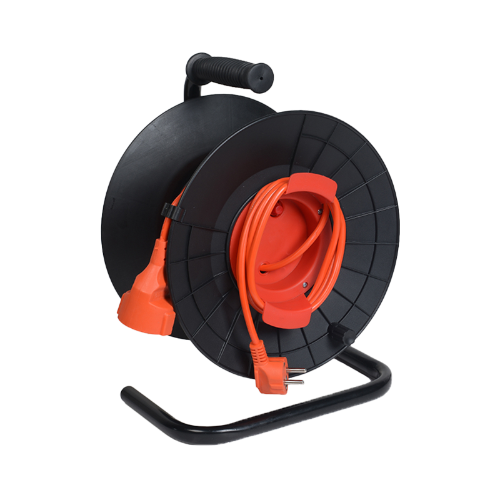Retractable cable reels, also known as retractable cord reels or retractable cable drums, are devices designed to store and manage electrical cables, cords, or hoses. They are commonly used in various industrial, commercial, and domestic applications to provide a convenient and organized way to handle cables. The structure of a retractable cable reel typically consists of the following components:
Drum or Spool: The drum or spool is the central component of the retractable cable reel. It is typically cylindrical or disc-shaped and provides the storage space for the cable. The drum is often made of durable materials such as plastic or metal to withstand the tension and winding forces.
Cable: The cable is the flexible electrical or communication wire that is wound and stored on the drum. It can be made of various materials, including copper or fiber optics, depending on the intended application. The cable is typically coiled or wound in a spiral pattern on the drum.
Spring Mechanism: The retractable feature of the cable reel is achieved through a spring mechanism. This mechanism is typically located inside the drum and is responsible for applying tension to the cable, allowing it to retract back onto the drum when not in use. The spring mechanism is usually a coiled spring that is connected to the drum and exerts a pulling force on the cable.
Ratchet and Pawl System: To control the extension and retraction of the cable, a ratchet and pawl system is often employed. This system consists of a ratchet wheel attached to the drum and a pawl or locking mechanism that engages with the ratchet wheel. The pawl prevents the cable from unwinding when it is not being pulled, while allowing controlled extension and retraction when the cable is pulled or released.
Handle or Grip: Retractable cable reels may have a handle or grip on the drum or on the outer casing. This allows users to easily carry or transport the reel and provides a means to manually pull or release the cable.
Mounting Bracket: Many retractable cable reels come with a mounting bracket or attachment mechanism that allows them to be securely fixed to a wall, ceiling, or other surfaces. The mounting bracket ensures stability during cable extension and retraction and helps keep the reel in place.
Outer Casing: The outer casing or housing provides protection for the internal components of the cable reel, such as the drum, spring mechanism, and ratchet system. It is usually made of durable materials, such as plastic or metal, and may have openings or slots to allow the cable to extend and retract smoothly.
Besides,Retractable cable reels can be classified based on various factors, including their design, application, and features. Here are some common classifications of retractable cable reels:
Manual vs. Motorized: Retractable cable reels can be classified as manual or motorized. Manual cable reels require manual effort to extend and retract the cable. They typically feature a handle or grip that needs to be manually operated. Motorized cable reels, on the other hand, are equipped with an electric motor that automatically extends and retracts the cable with the push of a button or through remote control.
Industrial vs. Domestic: Retractable cable reels can be classified based on their intended use in industrial or domestic applications. Industrial cable reels are designed to handle heavy-duty cables and are typically used in commercial, construction, or industrial settings. They are built to withstand harsh conditions and heavy usage. Domestic cable reels are designed for lighter applications, such as in households or small workshops.
Single Cable vs. Multiple Cable: Cable reels can be classified based on the number of cables they can accommodate. Single cable reels are designed to handle one cable or cord at a time, while multiple cable reels can accommodate two or more cables simultaneously. Multiple cable reels are commonly used in applications where different types of cables need to be managed together, such as in audio-visual setups or stage productions.
Spring-Driven vs. Motorized Reels: Retractable cable reels can be further classified based on the mechanism used for cable retraction. Spring-driven cable reels utilize a coiled spring inside the reel, which provides tension to retract the cable. Motorized cable reels use an electric motor to automatically extend and retract the cable.
Portable vs. Fixed: Cable reels can be classified based on their mobility. Portable cable reels are lightweight and designed for easy transport and use in various locations. They often feature a handle or grip for convenient carrying. Fixed cable reels, on the other hand, are permanently installed or mounted in a specific location, such as on a wall, ceiling, or machinery.
Specialized Application: Some retractable cable reels are designed for specific applications or industries. For example, there are cable reels specifically designed for outdoor use, such as in gardens or construction sites, which feature weather-resistant components. There are also specialized cable reels designed for specific industries, such as medical environments, where cleanliness and hygiene are crucial.





 English
English русский
русский















